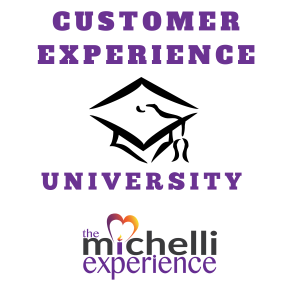Customer Experience University - Winning Loyalty & Engagement One Customer at a Time
Episodes

Thursday Mar 31, 2022
Thursday Mar 31, 2022
Dr. Michelli outlines 12 forms of pleasure or delight you can design into your customer and team member experiences.

Thursday Mar 24, 2022
PODCAST: Stick the Landing - How to Use the Peak End Theory to Amaze Customers
Thursday Mar 24, 2022
Thursday Mar 24, 2022
In this episode, Dr. Michelli offers 6 tips for leveraging the peak-end rule to your advantage.

Thursday Mar 17, 2022
Thursday Mar 17, 2022
In this installment, Dr. Michelli offers 5 tips for helping customers navigate transitions along their journey with you and your business.

Monday Mar 14, 2022
PODCAST - Moments of Truth: How to Master What Actually Matters to Customers
Monday Mar 14, 2022
Monday Mar 14, 2022
In this week's podcast, Dr. Michelli defines Moments that Matter Most and how the concept applies to driving belonging.

Thursday Nov 18, 2021
Thursday Nov 18, 2021
This is the final post in a 5-post series about my book Leading the Starbucks Way: 5 Principles to Connect with Your Customers, Your Products, and Your People.
In the context of Cherish and Challenge Your Legacy, I asked, then CEO of Starbucks, Howard Schultz what he wanted his legacy to be. He responded, “I want to build a lasting brand that elevates lives one cup at a time.” Upon his retirement a few years ago, it was clear to me that Howard’s legacy was intact. But that outcome wasn’t always certain. In fact, Howard had to return to the CEO position from his role as Chief Global Strategist to execute a bold transformational agenda that I chronicle in Leading the Starbucks Way. Howard and his leadership team had to also make difficult choices and invest wisely to ensure they stewarded a “lasting brand that elevates lives one cup at a time.”
What do you want your leadership legacy to be?

Tuesday Nov 16, 2021
5 Things Service Professionals Should ALWAYS Say…
Tuesday Nov 16, 2021
Tuesday Nov 16, 2021
Dr. Michelli discusses five things customer service professionals should always say...

Thursday Nov 11, 2021
Thursday Nov 11, 2021
This is the fourth in a 5-part series and we're continuing on through the business concepts in my book Leading the Starbucks Way: 5 Principles to Connect with Your Customers, Your Products, and Your People.
In the context of my principle, Mobilize the Connection, I talked with, then CEO of Starbucks, Howard Schultz about digital transformation. He noted, “We started before there was a digital revolution; the third place was our stores. Our mobile focus has evolved to the point where everyone is getting primary information and communicating in a way that was nonexistent before. I don’t think any enterprise or organization can exist in the future without having a primary relevant position in the minds and hearts of people through a digital platform. Many brands will come and go in terms of relevancy and trust in the digital world, as trust and relevance will be harder to maintain digitally than through a physical presence.”
Does your digital strategy integrate multiple approaches to engage people across a mass-market and individually?

Thursday Nov 04, 2021
Thursday Nov 04, 2021
This is the third in a 5-post series, How to Deliver World-Class Customer Experiences – Leading the Starbucks Way, as we continue through the business concepts in my book Leading the Starbucks Way: 5 Principles to Connect with Your Customers, Your Products, and Your People.
In the context of my principle, Reach for Common Ground, I highlight two competing perspectives held by cultural anthropologists - universalism and cultural relativism. While the words are daunting, the concepts are straightforward. Universalism suggests that the underlying similarities of all people are greater than cultural differences. By contrast, cultural relativism asserts that cultural differences have the most profound effect on people making it difficult for “outsiders” to fully understand a relevant context of behavior. While anthropologists may argue about universalism or cultural relativism, most business owners and leaders are not interested in winning a debate. Instead, we need to scale our business to maximize commonalities while making local adjustments to ensure market acceptance.
How do you determine if you should vary your offering or drive consistency across locations?

Thursday Oct 28, 2021
Thursday Oct 28, 2021
This is the second in a 5-post series, “How to Deliver World-Class Customer Experiences – Leading the Starbucks Way." In this installment, we continue to explore business concepts in my book Leading the Starbucks Way: 5 Principles to Connect with Your Customers, Your Products, and Your People.
When sitting across from Howard Schultz (the former CEO of Starbucks) it doesn’t take him long to get to the heart of leadership excellence which explains why I titled a Starbucks business principle “Love to be Loved.”
From Howard’s perspective, much of leadership comes down to three traits: “Take love, humanity, and humility and then place them in a performance-driven organization. Those humanistic elements in performance may seem in conflict to the naked eye. But I believe performance is significantly enhanced by human-centric leadership. I am convinced of it because we have become more performance-driven than at any other time in our history and the values of the company are at a high level. If we can infuse love, humanity, and humility on a global basis and build it into a performance-driven organization, we are unbeatable.”
In what ways are you managing through the lens of humanity while still maintaining high-performance expectations?

Thursday Oct 21, 2021
Thursday Oct 21, 2021
For context and based on requests, I’m in the process of presenting key concepts from my ten McGraw-Hill customer experience and leadership books. This is the first in a five-part series, “How to Deliver World-Class Customer Experiences – Leading the Starbucks Way."
The story of Starbucks' meteoric growth during the 1990s and early 2000s is well chronicled in a series of books about the company including one I wrote titled The Starbucks Experience. However, by the mid-2000s the company was reeling from years of frenzied expansion, an obsession for year-over-year sales numbers, a sliding global economy, and less frequent visits from loyal customers in Starbucks’ U.S. stores.
In the book, I wrote during the Starbucks revitalization titled Leading the Starbucks Way: 5 Principles to Connect with Your Customers, Your Products, and Your People, I outlined leadership and customer experience tactics that supported Starbucks' transformation plan.
To effectively elevate Starbucks to “be the undisputed coffee authority,” leadership redoubled efforts to drive a passion for the company’s core offering - coffee. While many leaders do not view product passion as a necessary component for sales success, it certainly differentiates sales leaders like Starbucks from most other competitors.
What are you doing to help your people become the undisputed authority in your sector?